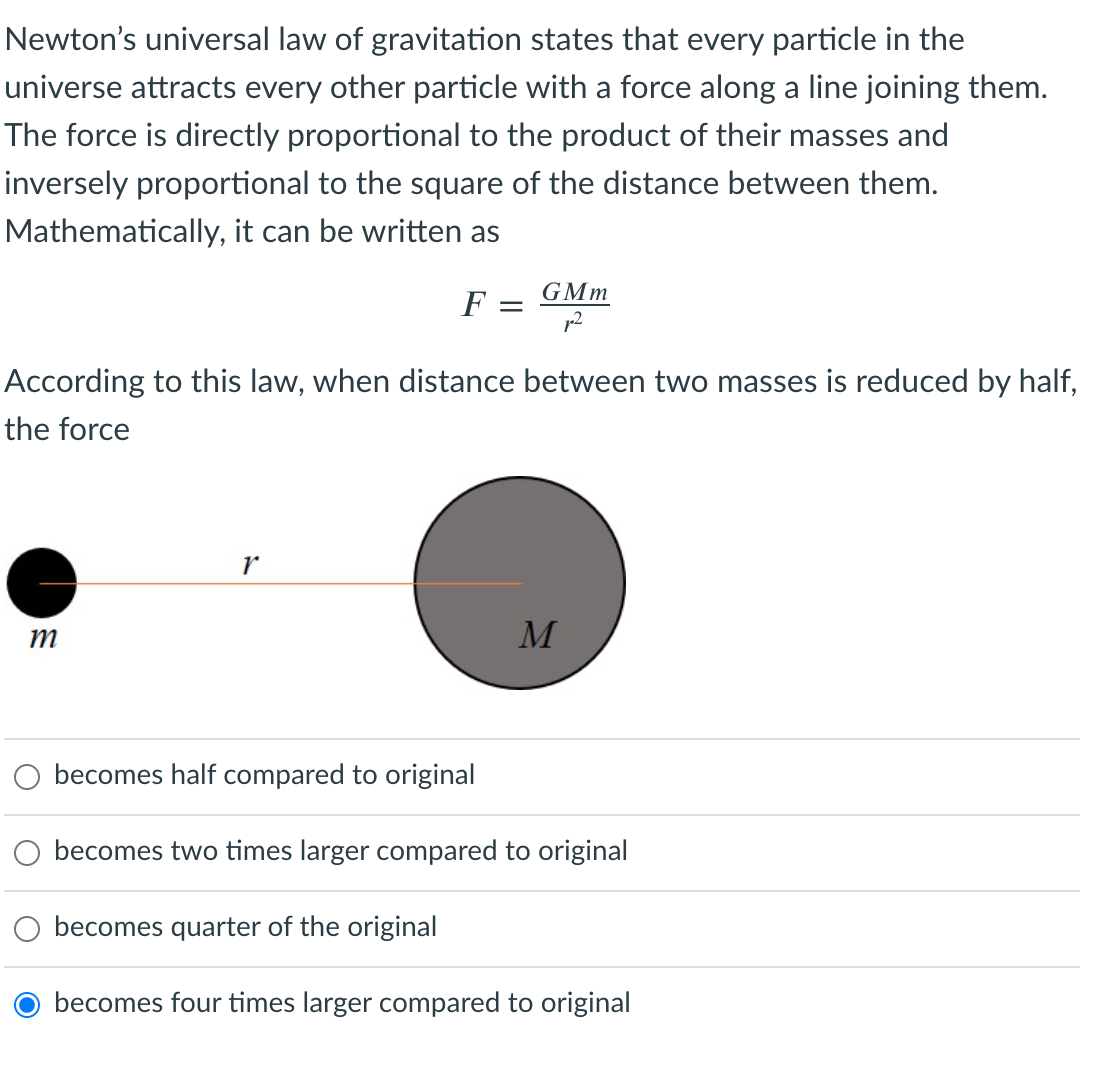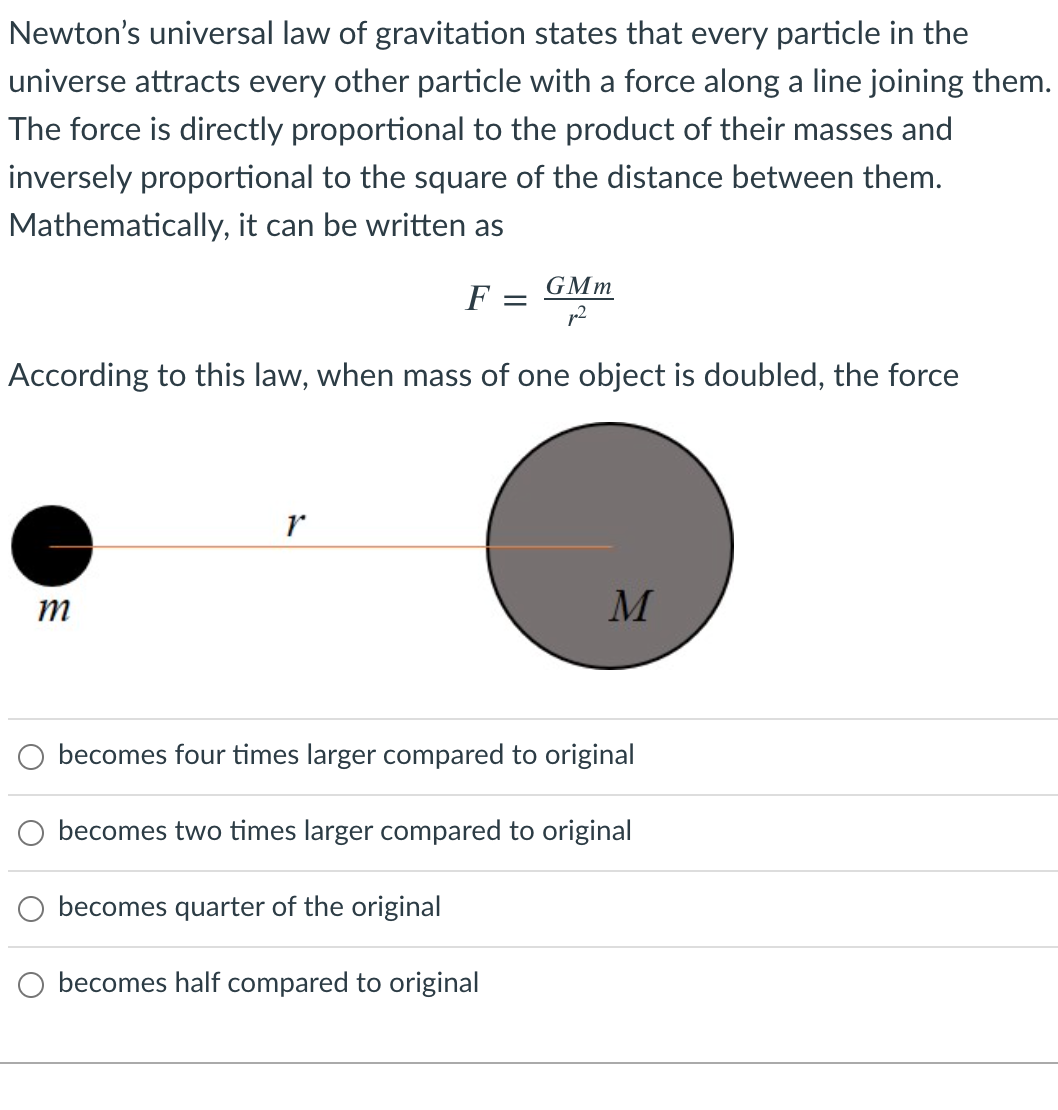Newton's universal law of gravitation states that every particle in the universe attracts every other particle with a force along a line joining them. The force is directly proportional to the product of their masses and inversely proportional to the square of the distance between them. Mathematically, it can be written as GMm F = According to this law, when distance between two masses is reduced by half, the force r becomes half compared to original O becomes two times larger compared to original becomes quarter of the original becomes four times larger compared to original
Newton's universal law of gravitation states that every particle in the universe attracts every other particle with a force along a line joining them. The force is directly proportional to the product of their masses and inversely proportional to the square of the distance between them. Mathematically, it can be written as GMm F = According to this law, when distance between two masses is reduced by half, the force r becomes half compared to original O becomes two times larger compared to original becomes quarter of the original becomes four times larger compared to original
Physics for Scientists and Engineers: Foundations and Connections
1st Edition
ISBN:9781133939146
Author:Katz, Debora M.
Publisher:Katz, Debora M.
Chapter39: Relativity
Section: Chapter Questions
Problem 9PQ
Related questions
Question

Transcribed Image Text:Newton's universal law of gravitation states that every particle in the
universe attracts every other particle with a force along a line joining them.
The force is directly proportional to the product of their masses and
inversely proportional to the square of the distance between them.
Mathematically, it can be written as
GMm
F =
According to this law, when distance between two masses is reduced by half,
the force
becomes half compared to original
O becomes two times larger compared to original
becomes quarter of the original
becomes four times larger compared to original

Transcribed Image Text:Newton's universal law of gravitation states that every particle in the
universe attracts every other particle with a force along a line joining them.
The force is directly proportional to the product of their masses and
inversely proportional to the square of the distance between them.
Mathematically,
can be written as
GMm
F
According to this law, when mass of one object is doubled, the force
m
M
becomes four times larger compared to original
becomes two times larger compared to original
becomes quarter of the original
becomes half compared to original
Expert Solution
This question has been solved!
Explore an expertly crafted, step-by-step solution for a thorough understanding of key concepts.
This is a popular solution!
Trending now
This is a popular solution!
Step by step
Solved in 3 steps with 3 images

Recommended textbooks for you

Physics for Scientists and Engineers: Foundations…
Physics
ISBN:
9781133939146
Author:
Katz, Debora M.
Publisher:
Cengage Learning

Physics for Scientists and Engineers, Technology …
Physics
ISBN:
9781305116399
Author:
Raymond A. Serway, John W. Jewett
Publisher:
Cengage Learning

Principles of Physics: A Calculus-Based Text
Physics
ISBN:
9781133104261
Author:
Raymond A. Serway, John W. Jewett
Publisher:
Cengage Learning

Physics for Scientists and Engineers: Foundations…
Physics
ISBN:
9781133939146
Author:
Katz, Debora M.
Publisher:
Cengage Learning

Physics for Scientists and Engineers, Technology …
Physics
ISBN:
9781305116399
Author:
Raymond A. Serway, John W. Jewett
Publisher:
Cengage Learning

Principles of Physics: A Calculus-Based Text
Physics
ISBN:
9781133104261
Author:
Raymond A. Serway, John W. Jewett
Publisher:
Cengage Learning

University Physics Volume 1
Physics
ISBN:
9781938168277
Author:
William Moebs, Samuel J. Ling, Jeff Sanny
Publisher:
OpenStax - Rice University

Classical Dynamics of Particles and Systems
Physics
ISBN:
9780534408961
Author:
Stephen T. Thornton, Jerry B. Marion
Publisher:
Cengage Learning

Modern Physics
Physics
ISBN:
9781111794378
Author:
Raymond A. Serway, Clement J. Moses, Curt A. Moyer
Publisher:
Cengage Learning